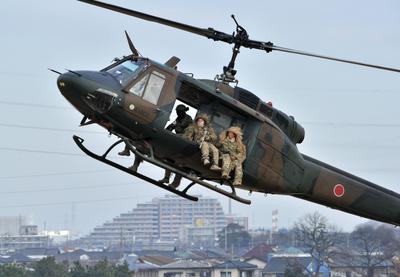Will this new cabinet decision really lead to the radical rearrangement of Japan’s grand strategy, strategic thinking and military posture?
Some certainly think so. The New York Times immediately declared that this was a ‘military shift to thwart China’ that would free Japan’s military ‘for the first time in over 60 years to play a more assertive role in the increasingly tense region’. On the other hand, the Chinese edition of the Global Times expressed concern that Japan can now ‘start going overseas for its killing spree again’. China’s Foreign Ministry Spokesperson Hong Lei in a much more measured tone questioned whether Japan was ‘deviating from the path of peaceful development that it has been upholding since the end of WWII’.
It is important to note that under the new conditions for defence mobilisation the SDF will only be dispatched to support allies under attack on the condition that the attack poses a clear danger to Japan and threatens to overturn the foundation for the enjoyment of Japanese citizens’ rights. ‘True’ collective self-defence (honrai no shūdanteki jieiken), though, is a right which allows a nation to deem an attack on an ally or partner that presents no danger to itself as equivalent to an attack on itself and respond with the use of force. This means the range of situations in which ‘defence mobilisation’ can be invoked by the Japanese government will be somewhat limited from the outset.
The SDF is a military that is highly constrained in its activities as it can only operate on the basis of enabling laws passed through parliament. This positive list approach differs from many other countries in that if a specific activity is not explicitly allowed by law, it is assumed to be prohibited.
But the Liberal Democratic Party’s (LDP) coalition partner, the New Komeito, is highly sceptical of passing new legislation that would involve Japan in ongoing hostilities. The cabinet decision therefore explicitly asserted that SDF logistics support to foreign militaries will be limited to support roles that do not put the SDF in combat zones. The SDF will also be required to cease activities if actual hostilities break out in an area of operation.
Within the context of these restrictions, the Abe administration will now push for the ability to defend allied warships in waters around Japan during a regional contingency that could lead to a direct attack on Japan. Previously, Japanese ships could only protect US ships on the high seas if they were acting to explicitly defend Japan. The SDF may also be given the right to inspect and intercept ships that are providing weapons to another nation attacking allied nations in waters close to Japan.
Minesweeping in Japan’s sea lanes without a formal cessation of conflict, as was previously required, is also on the agenda. The government will also attempt to better integrate Japan into region-wide ballistic missile defence networks centred on the US. The SDF may even be able to provide in-air refuelling of US fighter jets.
A benefit of the above changes could be that Japan’s potential involvement in a contingency, and therefore the costs of challenging the regional order, will become much more explicit. As it was, Japan was always likely to be a party to a conflict on the Korean Peninsula or around Taiwan whether it wanted to or not. Joint operation plans for regional contingencies will now be formed in more detail during peacetime, thereby increasing readiness and communicating resolve.
The overall impact of these changes will not, however, result in a change in Japanese regional strategic goals and will only result in incremental changes to Japan’s military posture. The central maritime security focus of Japan’s security policy and support for regional integration beyond military matters has changed little over the last four decades. The recent overemphasis on Sino–Japanese military competition in trying to understand Japan’s increased security cooperation with other nations in the region also completely misses the fact that the non-military dimensions of Japan’s new ‘comprehensive strategic partnerships’ are more important than the military aspects and will remain so.
Japan will not start acquiring the ability to strike overseas military bases and infrastructure. Nor will it develop significant expeditionary capabilities and strategic lift that would allow it to engage in high-intensity overseas combat and project coercive power in East Asia and beyond. The government’s stated goal is rather to prevent armed conflicts materialising and spilling over into Japanese territory and contribute to deterrence stability in East Asia.
Indeed, it is notable that even one of the most hawkish governments in Japan’s postwar history has been working overtime to assure the public that, whatever the outcome of the new changes, the SDF will not be involved in combat within other nation’s borders as other US allies have done during wars in the Middle East over the last 25 years.
Corey Wallace is a lecturer and professional teaching fellow at the University of Auckland.

